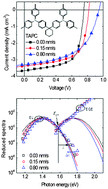Effects of the charge-transfer reorganization energy on the open-circuit voltage in small-molecular bilayer organic photovoltaic devices: comparison of the influence of deposition rates of the donor†
Abstract
The theoretical maximum of open-circuit voltage (VOC) of organic photovoltaic (OPV) devices has yet to be determined, and its origin remains debated. Here, we demonstrate that VOC of small-molecule OPV devices can be improved by controlling the deposition rate of a donor without changing the interfacial energy gap at the donor/acceptor interface. The measurement of external quantum efficiency and electroluminescence spectra facilitates the observation of the existence of charge transfer (CT) states. A simplified approach by reusing the reciprocity relationship for obtaining the properties of the CT states is proposed without introducing complex techniques. We compare experimental and fitting results and propose that reorganization energy is the primary factor in determining VOC instead of either the CT energy or electronic coupling term in bilayer OPV devices. Atomic force microscopy images indicate a weak molecular aggregation when a higher deposition rate is used. The results of temperature-dependent measurements suggest the importance of molecular stacking for the CT properties.


 Please wait while we load your content...
Please wait while we load your content...